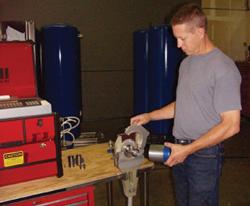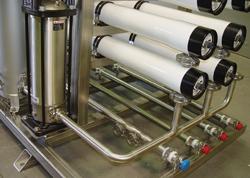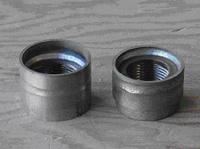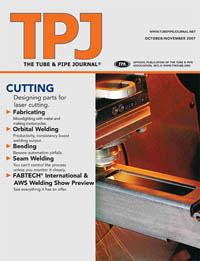- FMA
- The Fabricator
- FABTECH
- Canadian Metalworking
Categories
- Additive Manufacturing
- Aluminum Welding
- Arc Welding
- Assembly and Joining
- Automation and Robotics
- Bending and Forming
- Consumables
- Cutting and Weld Prep
- Electric Vehicles
- En Español
- Finishing
- Hydroforming
- Laser Cutting
- Laser Welding
- Machining
- Manufacturing Software
- Materials Handling
- Metals/Materials
- Oxyfuel Cutting
- Plasma Cutting
- Power Tools
- Punching and Other Holemaking
- Roll Forming
- Safety
- Sawing
- Shearing
- Shop Management
- Testing and Measuring
- Tube and Pipe Fabrication
- Tube and Pipe Production
- Waterjet Cutting
Industry Directory
Webcasts
Podcasts
FAB 40
Advertise
Subscribe
Account Login
Search
Orbital welding of stainless steel pipe for water systems
Productivity and quality improved over manual welding
- October 9, 2007
- Article
- Arc Welding
After being the industrial wing of a regional water treatment company for more than 15 years, American Water Technology Inc. (AWT), Redding, Calif., spun off as an independent company and settled into a market niche targeting small, mostly rural water districts with production of less than half a million gallons per day. These customers had been overlooked by big companies that provide larger water treatment packages and had been affected recently by tightened treatment specifications mandated by regulatory agencies.
Typically, many water specifiers look strictly at material cost for a new installation. However, ATW believed that it might be more interested in units that would require less maintenance and would have a long service life. As a result, the company decided to integrate stainless steel into its systems and use orbital welding equipment wherever possible.
"Stainless steel is the best material considering life cycle cost, sanitation, and physical properties, such as strength, for the water system operator. Other, cheaper materials simply cannot match stainless in the long run," said Chris Beebe, AWT's president.
Deciding to Go Stainless
The decision to use stainless steel tubing for its systems was based on AWT's examination of different methods and materials in an effort to reduce manufacturing costs and shorten production schedules while improving overall quality. At the time of the spinoff, AWT was primarily using PVC and CPVC on reverse osmosis (RO) systems and galvanized pipe on water softeners and filters. Both PVC and pipe require pipe-fitting techniques for manufacture, and glued assemblies require custom fit-up.
"We wanted to move toward a product line that had standard, repeatable, and interchangeable components. To that end, we looked at stainless steel tube," said Beebe.
Stainless steel also had the added benefit of sanitary compliance. The strength of stainless steel allows the use of higher water velocities that can help to minimize the growth of biofilm. Biofilm can be reduced by the higher velocities used for flushing systems, but higher flow rates also increase the risk of triggering a water hammer. Such force can fracture plastic piping but is more readily tolerated by stainless steel.
Orbitally Welded Stainless Steel Tubing
AWT's first experience with a welded stainless steel assembly was the face piping for a water softener. That project had comparable material cost to the other options; however, using manual welding took longer than the previous fabrication methods. In an effort to improve productivity, AWT decided to investigate using orbital welding equipment. Dave Buttress at Digital Welding in Sunnyvale, Calif., a representative of Arc Machines Inc. (AMI), Pacoima, Calif., demonstrated the orbital fusion welding equipment at AWT's facility.
"We could see the benefits of this technology right away" said Steve Bates, production manager for AWT.
Bates visited Arc Machines headquarters for training on the equipment. AWT rented an Arc Machines model 207 orbital welding system in late 2004. By March 2006, ATW was able to justify the purchase of its own system, which comprised a model 207A power supply with a model 8-4000 weld head.
Bates determined that Arc Machines' expertise saved the company both time and money. AWT's innovative approach to orbital welding was evident in the welding of the conductivity probes that require a female pipe thread (FPT) fitting-to-tubing joint. Based on Arc Machines' training, AWT developed its own weld schedules for this joint using step rotation, in which the electrode halts during the primary, or high-current, pulse to maximize penetration and moves on the background, or low-current, pulse. Making an orbital weld on the OD of FPT-to-tube weld results in what appears to be a fillet weld inside the tube even though no filler wire is added. AWT said that it could not have made this joint using manual welding techniques.

AWT uses an Arc Machines model 207A orbital welding power supply with a water-cooling unit and a model 8-4000 weld head for its stainless steel welds. Steve Bates holds a large tube that encloses the weldment for purging.
For another application, AWT needed a stainless globe valve with sanitary fittings. It purchased an off-the-shelf valve, machined the valve body, and orbitally welded sanitary ferrules onto the body.
Almost all of AWT's welds are done orbitally now. The repeatability of the process allows AWT to make interchangeable components so it can now make parts ahead of time. The portable model 207 power supply also allows the company to do on-site modifications or repairs. To date all of AWT's products have orbitally welded stainless tube assemblies, and 90 percent of its systems are built using stainless steel tube.
Using SolidWorks® CAD software, AWT prebuilds its assemblies. Drawings are made from the CAD models and components are fabricated from them. Tube is cut with a precision band saw, then end-prepped with a GF tube trimmer to make a square butt joint. Close tolerances are held to ensure interchangeability.
By converting to orbitally welded stainless steel, AWT now is able to produce uniform, interchangeable components. Upgrading both materials and fabrication technology has reduced the company's cost to a level comparable with PVC construction while producing a superior product.
About the Publication
subscribe now

The Tube and Pipe Journal became the first magazine dedicated to serving the metal tube and pipe industry in 1990. Today, it remains the only North American publication devoted to this industry, and it has become the most trusted source of information for tube and pipe professionals.
start your free subscription- Stay connected from anywhere

Easily access valuable industry resources now with full access to the digital edition of The Fabricator.

Easily access valuable industry resources now with full access to the digital edition of The Welder.

Easily access valuable industry resources now with full access to the digital edition of The Tube and Pipe Journal.
- Podcasting
- Podcast:
- The Fabricator Podcast
- Published:
- 04/16/2024
- Running Time:
- 63:29
In this episode of The Fabricator Podcast, Caleb Chamberlain, co-founder and CEO of OSH Cut, discusses his company’s...
- Trending Articles
Team Industries names director of advanced technology and manufacturing

Orbital tube welding webinar to be held April 23

Chain hoist offers 60-ft. remote control range

Push-feeding saw station cuts nonferrous metals

Corrosion-inhibiting coating can be peeled off after use

- Industry Events
16th Annual Safety Conference
- April 30 - May 1, 2024
- Elgin,
Pipe and Tube Conference
- May 21 - 22, 2024
- Omaha, NE
World-Class Roll Forming Workshop
- June 5 - 6, 2024
- Louisville, KY
Advanced Laser Application Workshop
- June 25 - 27, 2024
- Novi, MI




























